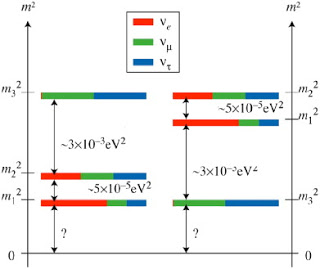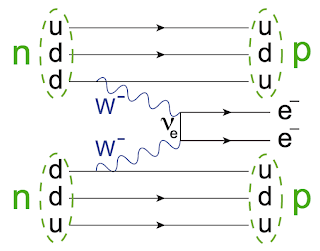Neutrino Astrophysics: Outstanding mysteries
, 3 min, 412 words
Tags: physics neutrinos particle-physics astrophysics
As you've probably guessed by now, there's a lot we don't know about neutrinos and how they function in astrophysics. They have a lot of mysteries in store for us. Here are a few:
- Value of $\theta_{13}$ and the neutrino mass hierarchy. Remember the mixing angles from the discussion of neutrino oscillations? Well, we know two of them fairly well, including their signs, but we have very little information on $\theta_{13}$. This is particularly interesting because the sign of that particular mixing angle will tell us how the masses of the mass eigenstates are related. There are two possibilities: the natural mass hierarchy, in which $m_{\nu_1}<m_{\nu_2}<m_{\nu_3}$ (shown at left below), and the inverted mass hierarchy, in which $m_{\nu_3}<m_{\nu_1}<m_{\nu_2}$ (shown at right below).

- Dirac/Majorana neutrinos. There is a bit of an outstanding question on whether the neutrino has a distinct antiparticle (Dirac neutrino) or is its own antiparticle (Majorana neutrino). If it is a Majorana particle, then processes such as neutrinoless double-beta decay could occur, in which two neutrinos annihilate in joint beta decay of two neutrons. This is a highly sought-after reaction, and there are legions of physicists working to find or rule out such a reaction.

- Other neutrino sources. We've spotted neutrinos from a supernova before, but we should also be able to detect some from other astrophysical sources, like active galactic nuclei (really bright spots caused by accretion around a supermassive black hole) and gamma ray bursts (possibly bright bursts from rapidly rotating supernovae - is physics awesome, or what?). Detecting neutrinos from such events may help us understand what's going on in high-energy events. In summary, neutrinos are pretty awesome little particles. They can be useful in understanding phenomena that light can't easily bring us information about, and they have a lot of mysteries left for us to sort out.
This is the seventh and final post in a series on neutrino astrophysics. Other neutrino-related posts can be found here.